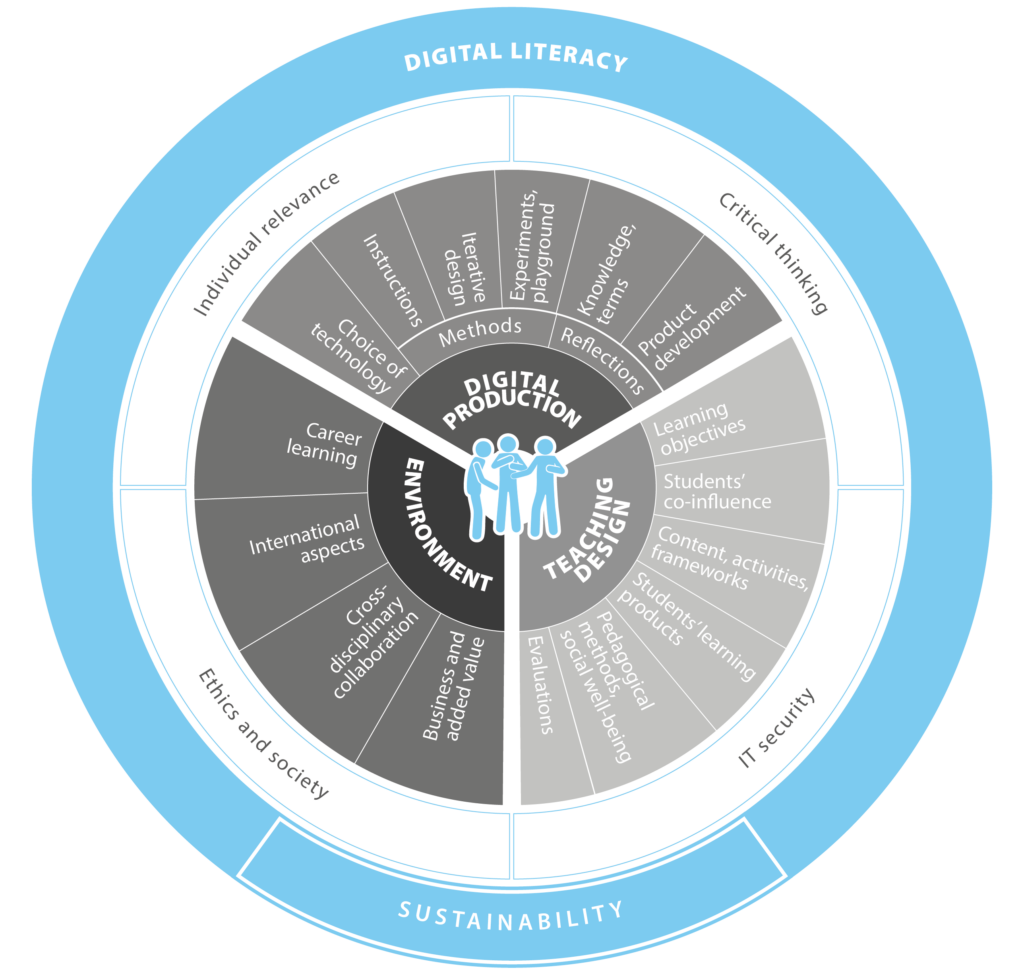Formative evaluation MYRE DK-DE: final findings
The following findings are an extract from the final evaluation (Majgaard, Dec. 2024), supplemented with quotations from teachers, managers, companies, and students.
For a comprehensive outline of methods, results, and findings, see evaluation report, SDU (February 2025).
Students´ learning
In total, the teaching modules have clearly highlighted students’ learning and progression. In each module, students created digital learning products, helping them adapt more effectively to emerging technologies. These hands-on experiences offered them valuable insights into the advantages and disadvantages of the technologies explored.
I believe these technologies will be used much more in the future and will accompany us even more.
Student, RBZ Wirtschaft Kiel
Through the creative and practical approach to the topics of robotics, sensor technology, and AI, the students have improved their technical understanding and English skills while also acquiring important competencies in critical thinking, teamwork, and presentation.
M. Alkio & P. Wenzel, lecturers, RBZ Wirtschaft Kiel
The students´ digital products are impressive. Many ideas are much more well-developed than expected.
Company assessor, MYRE DK-DE
We have focused on strengthening our students' competencies for the future job market. Through teaching modules with emerging technologies, our students have been given a unique opportunity to prepare for the technological changes that will shape our society. Our students have gained insight into how these technologies can be applied in practice, by experimenting and exploring their potentials.
Headmaster Svendborg Erhvervsgymnasier
Teaching modules
Key aspects of the evaluation included considerations of the modules’ a) teaching design, b) digital production, c) digital literacy, and d) interaction with external contexts. These dimensions are outlined in the model ROBOdidactics.
Most of the teaching modules were strong in all four dimensions.
In addition, nearly all moduled incorporated elements related to the Sustainable Development Goals (SDGs), such as the Danish level crossing “Electric go-karts and Kinematics” and the German “With robotics on mission to Mars” on high school level. This approach has obviously raised teachers’ and students’ awareness of the diverse aspects of the SDGs and the impact of the technologies in these contexts.
Crosscultural aspects were particularly addressed in for example the modules DK HHX Svendborg/DE RBZ Kiel ”Across borders: digital learning” Infostand Berlin, and in DK HHX Svendborg “ChatGPT in the subject German language”.
Future jobs require a minimum of technology knowledge and skills.
Teacher, MYRE DK-DE
Exchange and mutual inspiration fostered
The above mentioned infostand Berlin (“Across Borders: Digital Learning”) was launched through a close collaboration between RBZ and Svendborg HHX. The module emerged from initial cross-national discussions between the MYRE teachers and developed collaboratively with the participation of 2 Danish students and 4 German students, all of whom were young women. Danish HHX students created avatars designed for German students who were curious about the Danish education system and student life. Furthermore, The influence of a Tech Workshop at SIMAC in Svendborg led to RBZ Kiel acquiring underwater drones for testing in autumn 2024 and smaller drones for “Science Days”.
This strengthened relationship also paved the way for a planned student exchange in the German subject area set for autumn 2025 and an application for a new bilateral funding application. It takes more effort to work across boarders than locally sector-crossing. Therefore, in the follow-up project will focus on kickstarting these bilateral transnational collaborations.
Teachers' competencies in practice
In both countries, the leading teaching forces could be described as “early adopters” or even “innovators” (Rogers´ innovation curve) within their own schools.
These teachers eagerly embraced new technologies, each in relation to their respective subjects and educational programs. Consequently, the project served as a framework for exploring ways to integrate emerging technologies into didactics.
By exchanging ideas in a structured manner based on the ROBOdidactics model, teachers gradually recognized and acknowledged the efforts of their colleagues across the border, despite significant differences in their approaches.
Over time, the core group of innovative teachers expanded, as successful and impactful teaching modules were presented in the schools involved.
More and more teachers and lecturers participated in the project’s network meetings, workshops, and final events. These new educators can be categorized as “early majority”.
It has clearly been accepted by the participants that genuine collaboration involves an open-minded approach to both giving and receiving inspiration from one another. This approach is rooted in a willingness to understand and respect each other’s professionalism and choices.
During MYRE DK-DE, the partners became open to questioning their own approaches and adopting insights from one another. As a result, the exchange led to collectively searching for even better solutions.

Everett M. Rogers “Diffusion of innovations” (1962), The Free Press, New York
I've gained new perspectives on integrating technology into teaching, particularly how AI tools like ChatGPT can enhance student learning by supporting language correction, fostering critical thinking, and improving digital literacy.
Teacher, MYRE DK-DE
´DigiDidactics´

´DigiDiadctics´ (Oct. 2024) resulted from a border-crossing process for updating the common didactic framework ROBOdidactics.
Didactics
At network meetings, workshops and events hosted by all network participants, the teaching modules were presented, based on the ROBOdidactics model.
The modules were showcased both during the development phase and in the evaluation phase after the teaching sessions had been completed.
This gave educators the opportunity to delve into the “engine room” of other educators, exploring both their academic and didactic approaches. Thus, the network meetings contributed to local capacity building.
The Robodidactics model was further developed into the new DigiDidactics model during a dedicated workshop at RBZ Wirtschaft Kiel. Feedback on the former model highlighted that it was too detailed and not entirely intuitive for especially new users.
During the workshop, ideas were shared on how to improve the model, with particular attention given to emphasizing the unique aspects of Digital Literacy and Digital Production, which are central to the model. This proces led to a revised version of the model that better underscored these distinctive features.
In addition to these features, the model’s emphasis on looking outward—towards the educational chain and the surrounding world—is seen as essential when working with students transitioning into further education or the workforce.
However, the new version of the model remains overly detailed, despite efforts to simplify it. In an upcoming cross-national collaboration, further work will be done to streamline and to simplify the model, and provide a guideline.
MYRE DK-DE has received financial support from PKP | Interreg Deutschland – Danmark.
In addition to the 35% co-financing, the three project partners have contributed significant own resources and engaged a wide range of network partners.




